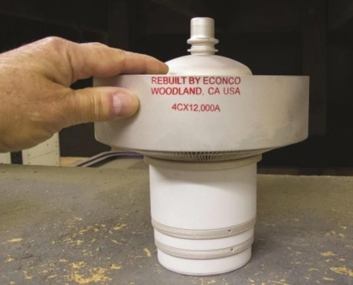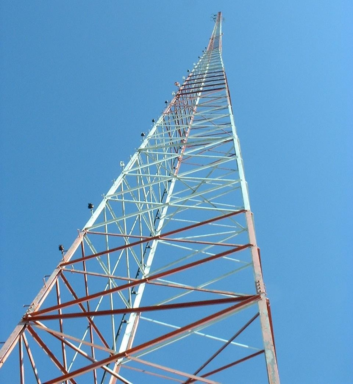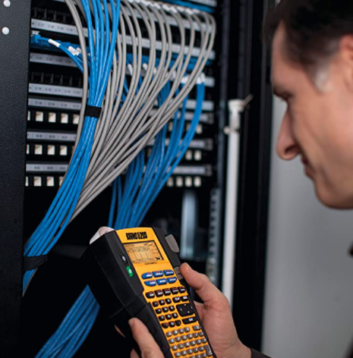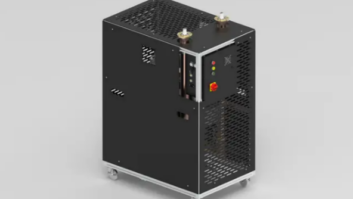 Jeff Welton is Nautel’s regional sales manager for the central U.S., but that job title doesn’t capture his better-known role as “go-to” guy for technical tips, problem-solving and entertaining public presentations.
Jeff Welton is Nautel’s regional sales manager for the central U.S., but that job title doesn’t capture his better-known role as “go-to” guy for technical tips, problem-solving and entertaining public presentations.
The industry has caught on. In 2018 he received the Society of Broadcast Engineers James C. Wulliman Educator of the Year Award. In 2019 the Association of Public Radio Engineers handed him the APRE Engineering Achievement Award. And in 2020 he received the NAB Radio Engineering Achievement Award.
This conversation is from the Radio World ebook “Mission-Critical: Maintaining Your Transmitter Site.”
RW: When we’re talking about maintaining a site for broadcast radio operators, you have a philosophy.
Welton: I’m a guy who works for a transmitter company, but it’s a good philosophy for almost any electronic installation. The three principle tenets are: Keep it cool, keep it clean and keep it well grounded.
RW: There are hundreds of things we could talk about to meet those goals. Where do you start?
Welton: My wife likes to say that I can spot a butterfly half a mile away and go chasing it off into the wilderness, totally losing my train of thought. It’s easier for me to pick a specific task and approach that first.

I might walk into a facility and look at airflow direction and check to make sure that the air is going to the actual intake so the equipment that needs to be cooled. Or I might go in with a temperature meter — a Fluke infrared temperature sensor, or I’ve got one of the FLIR infrared camera attachments for my cellphone, it’s a wonderful tool — and do temperature readings to spot checks throughout the facility to see if there are any hotspots that may need additional air flow.
I may do another trip and just do a look-around and open a panel or two. If you’re seeing piles of dirt building up in your equipment, that’s a hint and a half that something needs to be done with air pressure and filtering. You look for the clues as you go. Obviously lightning protection and grounding are easiest. Stuff’s blowing up? You need to do more of it.
RW: Have you found that having fewer engineers coming into the business and fewer people who understand RF has made this a lot harder?
Welton: It does make it a little more challenging. With younger folks being so oriented toward IT and IP addresses, management [may forget] there’s still a big, heavy piece of equipment out there that generates heat and needs a lot of cooling and some maintenance.
We’ve been doing Tuesday webinars on maintenance and mentoring; you can find the archives on the Nautel website.
In addition to newer engineers who aren’t so intimately familiar with the big, heavy, glowing stuff, a lot of managers are working with lower budgets. When you’re running low on time and money, you’re not going to put as many resources towards maintenance — the oil changes, if you will.

But most people wouldn’t think of going 80,000 miles without changing the oil on their car, so why would you let the transmitter, which generates all the revenue or underwriting for your station, go for a full year without any maintenance whatsoever?
Especially in the year of COVID, where every day became a series of remote broadcasts as on-air hosts and DJs got moved to their living rooms, engineering gets stretched really thin, going from a couple of remote broadcasts a week to half a dozen a day. The resources for site maintenance and transmitter maintenance get stretched even thinner.
But you can’t leave the air filters in the transmitter until they’re covered with a half-inch of crud.
RW: Is that the most common problem you’re hearing about?
Welton: It’s a bunch of things. High winds get into ventilation systems because exhaust fans failed and weren’t putting the air out, so the wind blew the rain back into the transmitter.
I’ve had one that got snowed on. Several leaky roofs, several lightning-damaged systems as a result of lack of maintenance on the grounding system.
It’s more from a lack of attention or personal presence at the site to catch these things before they become an issue. Some of it may be purely financial. A new transmitter at a low-power level costs a couple of thousand dollars, an engineer costs tens of thousands, so do the math; it’s cheaper to replace the transmitter every so often. It’s a conscious decision in some cases. In other cases, “We got busy and forgot.”
RW: What is the recommended frequency of visiting a remote site for general inspection?
Welton: If I’ve got a site in a cornfield in Iowa, where I’m dealing with windblown dust on a regular basis, it needs to be visited once a month, especially in the summer. If I’ve got a sealed air-conditioned facility and a company was contracted to come in to clean the heat exchanger coils, I may visit that once a year.

I’ve done Mississippi in cottonwood season; if you’re running a forced air system, you’re going to be down there every couple of weeks in July and August.
It will depend on your sites; but there needs to be a schedule and you can’t vary from it too much.
RW: Let’s imagine getting ready to go to a site for a monthly inspection. What’s in your kit?
Welton: The number one tool is the two-foot bolt cutters! I call it the skeleton key — for when a power company guy changed locks around my lock at a multi-access site.
Then my infrared camera, which I can attach to my cellphone. I can power it up as I walk in the building, and point it at the power panels and run it over the coax, looking for any hotspots before I’ve even unpacked my gear.
A caveat is that you need to have a non-reflective surface. Especially with laser-guided infrared cameras, reflective paint can skew the readings. (I’m Canadian so I like hockey tape, a cloth-based tape with matte finish that sticks really well; you can stick that on your electrical panel.)
After the temperature sensor, a small kit of hand tools with a knuckle-buster — a crescent wrench or adjustable wrench.
With stuff coming in from overseas, I’m going to want a combination of metric and Imperial tools.
A Leatherman or Gerber [multi-tool], at your preference, so you’ve got Phillips and flathead screwdrivers.
If I knew I’d be looking at air filters, I’d want a full set of air filters and belts for the blowers already at the transmitter site, or in my toolkit.
I carry a first aid kit, rather than putting electrical tape, an old paper towel or shop rag on our finger when we cut it. I am known for sticking my fingers in places I probably shouldn’t have stuck them.
RW: Ideally you would bring someone with you for safety reasons, but that’s probably not practical for a lot of stations.
Welton: The person doesn’t have to be RF-trained. Have somebody there, show them where the circuit breaker is in case you get connected across something you shouldn’t be connected across.
They need to be able to call 911, whether it’s a landline or a cell phone, depending on the service area. A lot of sites tend to be above cell coverage. But have a way to reach emergency services.
Beyond that, they’re there to make sure you don’t do anything foolish. Ideally somebody who doesn’t distract you from what you’re doing.
A lot of engineers take their significant other. Or grab the general manager. It’s good to have the GM go. I still run into GMs who don’t know where their site is.
RW: If time is limited and you’re doing a regular visit rather than responding to a specific problem, what are you checking?
Welton: Anything that handled air — whether it’s a filtered air intake, an open-air intake transmitter, air filters, heat exchanger coils on an air conditioning system. Check the cooling system, whatever it happened to be.

Listen for blower belts that might be starting to squeak or getting a little persnickety.
If it’s a generator site, I’d run the generator to make sure it started. On a regular basis, you also need to do a full load test and switch the whole site over to generator.
Check the foliage. Look for carcasses like snakes or other kind of vermin in and out of the building.
If it’s an AM, I’m glancing at the base insulator and taking a quick check on guy wire anchors. Just do a physical once-over. Walk around.
RW: You’ve probably seen things that made you shake your head.
Welton: A few. I walked into one site where I was convinced, by the end of the visit, that the engineer was trying to find a way to commit suicide. It was the scariest thing I’d ever seen. Open panels, bypassed interlocks, the tuning unit had overgrown to the point you were running a risk of tripping or falling just going into the antenna enclosure.
He had been unwell and somebody had been covering; but it was a collection of “This is not really good.”
For the most part, people take pride in their facilities. But there are times when you’ll see pieces of Schedule 90 conduit lying on the floor waiting for somebody to step on them, go for a ride, bang their head on a cabinet and lay there unconscious until somebody finds them.
The safety thing is critical. I don’t go into any site where I’m going to be touching electrical stuff without safety shoes on. It’s just a given. They’re a cheap investment and good insurance.
But if you look at the number of engineers found at transmitter sites, most of the time it wasn’t electricity that killed them. It was a trip and a fall and bang your head on something, or a heart attack, or an intruder.
We get too busy doing things. You put in a full day at the studio or in meetings, and then a transmitter goes down, and you spend the next 12 hours at the transmitter site. Sometimes you need to know when it’s time to pull the plug and say, “I’m too tired to do this coherently, and I’m a danger to myself and my equipment.”
RW: You’re not doing the station any good if you get yourself killed —
Welton: Right.
RW: Or yourself.
Welton: Well —
RW: Go ahead.
Welton: Somebody used to say, “Nobody ever died from a lack of rock ’n’ roll.”
RW: Are there common questions or service issues that come up?
Welton: I get a lot of questions on grounding. If you’re laying on a new site and want a good resource to get started, I refer people to the grounding for transmitter stations paper in the Resources tab of our website. Or Google the Motorola R56 standard. It goes into massive detail. If you follow that, you’re probably going to have the best grounded facility you can have.

One of the biggest questions I get is when somebody is putting a new piece of equipment into a facility that they’ve owned for decades and that has seen several transmitters, several engineers, and things have been laid on top of other things. Sometimes you need to assess whether it’s best to rip it all out and start again or whether you can add without creating loops and more challenges. Just take the time to sit down and assess where you are before you start.
The bulk of what we see in emergency situations? You’re not going to stop an “out-of-a-blue 200,000 amp lightning strike,” but the vast majority of [problems] could have been prevented by scheduled site visits and replacement cycles.
Everybody’s like, “Oh, the transmitter guy’s saying buy a new transmitter.” Well, I’m not saying buy a new transmitter this week. But when you have a piece of gear that’s 40 years old, you probably should be starting to think about the time to get a new one. And the best time is not when it’s got smoke coming out the top of it.
RW: We’ve all heard stories about an engineer finding a bullet hole in a pressurized line. That makes me think about the question of personal safety. Are a lot of clients going up there with a sidearm?
Welton: I’m a Canadian, which is an unarmed American with health insurance. I’m not really qualified to answer that. But I grew up in a farm country with guns, and when we went back in the woods, typically we had a weapon with us of some sort, whether it was for vermin control or because we had bears back there.
The Alaskan folks, you better have a sidearm going up there because running into a Kodiak bear is going to make for a bad day.
Sometimes it’s not the rural sites. Some of the urban locations I’ve been to — I was at a site in Houston where they had double razor wire fencing, and you had to go in through the outer gate, and the inner gate wouldn’t open until the outer gate was closed.
Again, it’s situational. I’ve got sites in Wyoming where I wouldn’t think anything of driving in there at one o’clock in the morning. You might see a bighorn sheep.
If you’re coming to a facility, you’re not familiar with, do it during the day until you get a feel for the area.
RW: There’s so much we could talk about — documentation or stocking the facility with emergency supplies.
Welton: Oh my goodness. Documentation. You said that and my eyes lit up.
So often, things are done with no hint of a note as to what was done or why. Document everything.
The older I get, the less inclined I am to remember why I did whatever I did 20 years ago. Also, for the value of the station — at some point somebody is going to look at this going, “What was he thinking?”

[At one time] you walked into a site, the first thing you did was sign into the logbook; and before you left, you filled in notes on everything you did. We need to get back to that.
With tools like Evernote, you can do audio transcription or attach photos, put in handwritten notes and have character recognition — tools like that on a cellphone are huge.
Now, doing a full spreadsheet, a list of every wire in the facility, starting from scratch, that’s going to take some time; but it takes a lot less to update it as you go than it does five years from now to have to create it from nothing.
So, document, document, document.
RW: Is there a section of the Nautel website you want people to be aware of?
Welton: When you go to the support page, there are links to “how-to” videos. If the service guys get regular calls on something they’ll create a short how-to video for our YouTube channel.
And there’s the latest software. Things we used to do with bags of resistors, capacitors and a sheet of instructions are done with software updates now, so you can find the latest software, read through the release notes to see if it applies to your situation. And my “Tips and Tricks” articles, the quarterly Waves newsletter that we put out.
RW: Final thoughts, Jeff.
Welton: The laptop is less a luxury item than a necessary tool. Obviously we pioneered this with the AUI back in the early 2000s, but more and more equipment will have features that you can access over an IP connection that you won’t necessarily have access to from the front panel.
For a contract engineer, you almost can’t do your job properly without a station or personal laptop or a tablet anymore. Some sort of electronic device that you can plug into an RJ-45 connection.
A Few More Tips
Here’s a further sampling from Welton’s “Tips and Tricks” presentations:
- Steel wool is an effective barrier to vermin when stuffed in gaps and cracks.
- Keep a full set of spare keys where they are easy to find. You will need them eventually.
- Change default passwords on all equipment.
- Use a VPN. There are free ones listed at techradar.com/vpn/best-free-vpn, but paid ones can be very affordable.
- Keep spare batteries handy and remember they have a shelf life. Change frequently on smoke detectors and any key components where batteries provide backup.
- Provide backups to your STL or other primary link. Is there a redundant method of control?
- Take advantage of the Alternative Broadcast Inspection Program to check yourself and to help keep your staff aware of relevant rules.












